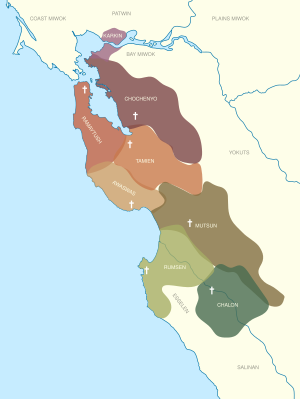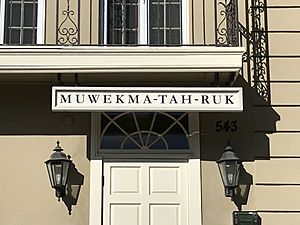Ohlone languages facts for kids
Quick facts for kids OhloneCostanoan |
|
|---|---|
| Ethnicity: | Ohlone |
| Geographic distribution: |
San Francisco Bay Area |
| Linguistic classification: | Yok-Utian
|
| Subdivisions: |
Karkin †
Northern
Southern
|
 Pre-contact distribution of the Ohlone languages
|
|
The Ohlone languages, also called Costanoan, are a group of native languages spoken by the Ohlone people. Before Europeans arrived, these languages were spoken from the southern San Francisco Bay Area down to northern Monterey County. The Ohlone languages are part of a larger group called the Utian language family. Some experts believe that Ohlone, Miwok, and Yokuts languages all come from an even older family called Yok-Utian.
Contents
Ohlone Languages: A Closer Look
The Ohlone language family includes eight known varieties. These are Awaswas, Chalon, Chochenyo, Karkin, Mutsun, Ramaytush, Rumsen, and Tamyen. The differences between these Ohlone languages are similar to how different Romance languages (like Spanish and French) are from each other. This means that people from neighboring Ohlone groups could usually understand each other.
Sadly, the last native speakers of Ohlone languages passed away by the 1950s. However, some languages like Chochenyo, Mutsun, and Rumsen are now being brought back to life. People are relearning them using old recordings and written materials.
How Ohlone Languages Are Grouped
Experts have different ways of grouping the Ohlone languages. One common way, based on research by Catherine Callaghan, lists them like this:
- Karkin (also known as Carquin)
- Northern Costanoan
- Southern Costanoan
More recent studies suggest that Awaswas and Mutsun might be part of a "South Central Costanoan" subgroup.

Were They Dialects or Separate Languages?
For a long time, experts debated whether the eight Ohlone varieties were different dialects of one language or completely separate languages. Early linguists sometimes changed their minds on this topic.
One linguist, Richard Levy, first said they were just slight differences in dialect. But later, he concluded they were "as different from one another as Spanish is from French." Another researcher, Randall Milliken, initially thought they were dialects. He cited a missionary who said the languages seemed distinct but actually formed a chain where neighbors could understand each other.
However, Catherine Callaghan, a linguist who studied many original documents, found evidence that the Costanoan languages were indeed distinct. She suggested that only Ramaytush, Tamyen, and Chochenyo might have been dialects of a single language. Milliken later agreed with Callaghan, now referring to them as separate languages.
Ohlone Place Names
The Ohlone people lived in different tribes, groups, or villages. These groups were also part of one of the eight language regions identified by experts. Many native names were recorded in old mission records of baptism, marriage, and death.
Some names came from Spanish and Mexican settlers. Others were from early European travelers. Some important names came from the memories of Native American informants. These were native speakers who were still alive and could remember their group's language and details.
Many former tribe and village names were also found on old land maps. These maps were drawn when people applied for Spanish and Mexican land grants. A lot of information about these names is still available for research in libraries.
How Ohlone Words Were Written Down
When Spanish missionaries first heard Ohlone sounds, they wrote them down using Spanish as a guide. This meant there could be mistakes. Later, these words were translated into English, and their spelling changed over time. Different missionaries kept separate records, which also led to spelling differences.
Later, experts like Kroeber and Merriam interviewed Ohlone speakers. They were able to figure out some pronunciations and create word lists. These lists help linguists understand how the languages sounded. One famous list is "Selected Costanoan Words by Merriam."
Ohlone Words You Can Learn
Here are a few words from the Ohlone languages, taken from a list by Clinton Merriam. This list includes 400 Ohlone words from interviews with native speakers. The pronunciations are written as "phonetic English."
| English Word | Schedule #56 | Schedule #57 | Word # |
|---|---|---|---|
| Salmon | Oo'-rahk | Hoo"-rah-ka | 247 |
| Abalone | Oo==ch | Hah-shan | 254 |
| Redwood (Sequoia sempervirens) | – | Ho-o-pe | 280 |
| Valley Live Oak (Quercus agrifolia or Quercus lobata) |
Yū'Ks | You-kish | 296 |
| Big Round Tule | Rōks | Ró-kus | 409 |
Legend:
|
|||

